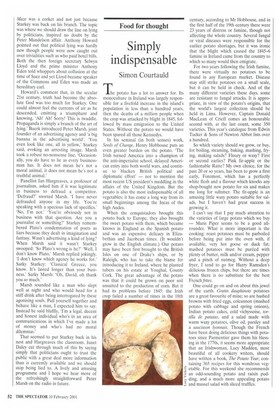Food for thought
Simply indispensable
Simon Courtauld
he potato has a lot to answer for. Its monoculture in Ireland was largely responsible for a fivefold increase in the island's population in less than a hundred years, then the deaths of a million people when the crop was attacked by blight in 1845, followed by mass emigration to the United States. Without the potato we would have been spared all those Kennedys.
In his seminal (in both senses) work, Seeds of Change, Henry Hobhouse puts an even greater burden on the potato. The Irish turned America into a champion of the anti-imperialist school, delayed American entry into both world wars, and continue to blacken British political and diplomatic effort' — not to mention the most recent US president's meddling in the affairs of the United Kingdom. But the potato is also the most indispensable of all vegetables; it has come a long way from its small beginnings among the Incas of the high Andes.
When the conquistadors brought this potato back to Europe, they also brought the sweet potato with them, which became known in England as the Spanish potato and was an expensive delicacy in Elizabethan and Jacobean times. (It wouldn't grow in the English climate.) Our potato may have been first brought to the British Isles on one of Drake's ships, or by Raleigh, who has to take the blame for introducing it to Ireland, where he planted tubers on his estate at Youghal, County Cork. The great advantage of the potato was that it could be grown on poor soil unsuited to the production of corn. But it had its problems before 1845: the Irish crop failed a number of times in the 18th century, according to Mr Hobhouse, and in the first half of the 19th century there were 23 years of distress or famine, though not affecting the whole country. Several fungal or viral diseases were responsible for the earlier potato shortages, but it was ironic that the blight which caused the 1845-6 famine in Ireland came from the country to which so many would then emigrate.
For two years following the Irish famine, there were virtually no potatoes to be found in any European market. Disease may still strike potatoes on a small scale, but it can be held in check. And of the many different varieties these days, some are resistant to fungal attacks. It is appropriate, in view of the potato's origins, that the world's largest collection should be held in Lima. However, Captain Donald MacLean of Crieff comes an honourable second with, at the last count, some 350 varieties. This year's catalogue from Edwin Tucker & Sons of Newton Abbot lists over a hundred.
So which variety should we grow, or buy, for boiling, steaming, baking, mashing, frying, making salads? Floury or waxy? First or second earlies? Pink fir-apple or the fashionable Ratte? My own choice, for the past 20 or so years, has been to grow a first early, Foremost, which has a perfectly white flesh and a flavour which knocks any shop-bought new potato for six and makes me long for suhuner. The fir-apple is an amusing little waxy potato suitable for salads, but I haven't had great success in growing it.
I can't say that I pay much attention to the varieties of large potato which we buy — Mans Piper seems to be a good allrounder. What is more important is the cooking: roast potatoes must be parboiled before being put into the oven with, if available, very hot goose or duck fat; mashed potatoes must be puréed with plenty of butter, milk and/or cream, pepper and a pinch of nutmeg. Without a deep fryer, I tend to go for Harry Ramsden's delicious frozen chips, but there are times when there is no substitute for the best French frites.
One could go on and on about this jewel of the earth. Gratin dauphinois potatoes are a great favourite of mine; so are hashed browns with fried eggs, colcannon (mashed potato with cabbage and spring onions), Indian potato cakes, cold vichyssoise, tortilla de patatas, and a salad made with warm waxy potatoes, olive oil, parsley and a saucisson lyonnais. Though the French have been doing delicious things with potatoes since Parrnentier gave them his blessing in the 1770s, it seems more appropriate that an Irishwoman, Lucy Madden, most beautiful of all cookery writers, should have written a book, The Potato Year, containing 365 recipes for this wondrous vegetable. For this weekend she recommends an odd-sounding potato and raisin pudding, and a much more appealing potato and mussel salad with sliced truffles.


































































 Previous page
Previous page